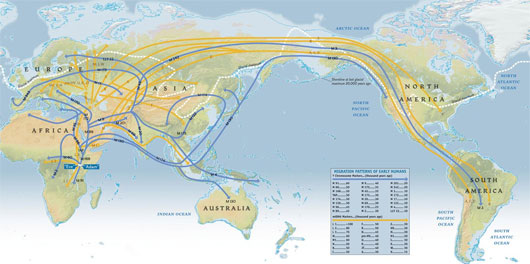Affirm the migration hypothesis of ancient people
The study looked at the entire genetic code of a common virus that causes human illness that confirmed the human migration hypothesis out of Africa - a controversial argument among anthropologists.
The type of virus studied is Herpes simplex type 1 virus (HSV-1) , which usually causes only mild ulcers in the oral area - Professor Curtis Brandt, Department of Medicine - Microbiology and Ophthalmology at UW-Madison. When Professor Brandt and colleagues compared 31 different gene sequences of HSV-1 collected from North America, Europe, Africa and Asia, they were amazed at how the viral gene sequences could be. divided into different groups, in which the viruses collected in Africa form a group, viruses from the Far East, South Korea, Japan and China form a group and all viruses from Europe and the United States. into another group.
'What we discovered was exactly the same as what anthropologists and genetics have pointed out from their human genetic studies, confirming that humans have originated in one place and then disseminated. "It's all over the planet," says Professor Brandt.

Migration map of ancient people.(Photo: BLACK HISTORY FACTION FICTION)
Human genetic studies have hypothesized that human ancestors originated in Africa around 150,000-200,000 years ago, after which a small part migrated to the Middle East and separated to the west to Europe. Asia and the east towards Europe. The HSV-1 virus may have followed ancient communities and evolved in different directions when they were allocated to migrations.
Another interesting discovery is that among the viruses collected in the US there is a gene that is not the same as that of European viruses, while modern American residents are European migrants. Europe. This individual virus is concentrated in Texas and very similar to the virus from Asia, implying another theory: Native Americans (also known as Indians) were Asians and emigrated. to the Americas through a land "bridge" that used to exist in the Bering Strait bay.
In addition to the important findings reinforcing the hypothesis of human migration, the technique used in this study may also contribute to future viral gene research, including branching, mutation steps. virus.
- New research changes understanding of the migration of ancient people
- New hypothesis toward migration of ancient people
- Genetic evidence of human invasion of the world
- People have nighttime sleeping habits thanks to ... extinct dinosaurs?
- The huge immigration came home to celebrate New Year in China
- Ancient people conquered many new lands thanks to El Nino
- History of dogs and American civilization
- Zebras record the longest migration on the continent
- Ancient Mars atmosphere resembles Earth
- See the migration process of animals in 3D
- Test hypothesis 'Matrix'
- New discoveries about the migration habits of monarch butterflies
 Discovered an ancient centipede fossil 99 million years old
Discovered an ancient centipede fossil 99 million years old Discovered bat-like dinosaurs in China
Discovered bat-like dinosaurs in China Discovered a 200-year-old bronze cannon of the coast
Discovered a 200-year-old bronze cannon of the coast Discover 305 million-year-old spider fossils
Discover 305 million-year-old spider fossils